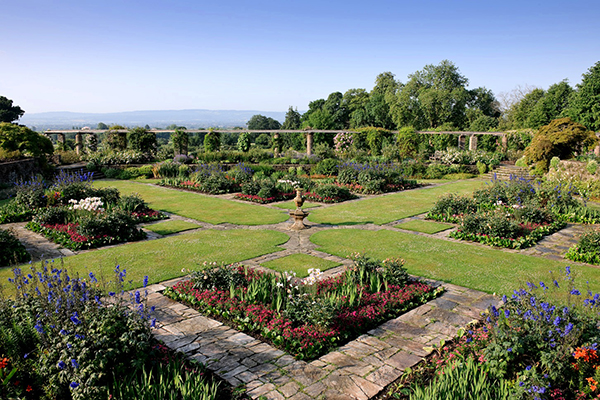David Worthington visits one of the South West’s horticultural triumphs

A few miles outside Taunton in Somerset is Hestercombe House, a historic stately home with an internationally important garden. Yet twenty years ago its eighteenth-century landscape had fallen into neglect and was hidden by conifers and rhododendrons.
Fortunately for Hestercombe, Britain is blessed with horticultural treasure hunters with vision and enthusiasm. One such is Philip White, now Chief Executive of the Hestercombe Gardens Trust. Originally from a Somerset farming family, Philip trained as a zoologist and took a job with the Somerset Wildlife Trust. The Trust’s offices were in Hestercombe House and pessimistic about farming’s future Philip had sold off his dairy herd to dedicate himself to preserving the South West’s flora and fauna. It was whilst walking in the grounds during his lunch hour that it occurred to him that behind the house there was something hidden. A keen gardener he spotted tell-tell signs: a mound here, a wall there, and all these clues pointed to a derelict grand garden. No one seemed to know who created it.
Somerset County Council had bought Hestercombe in 1953 and leased it to the fire brigade. The formal gardens at the front of the house had been restored. The valley at the back was owned and forested by the Crown Estates. Neither had any information or interest in the lost garden. For some reason Philip had a strong emotional draw to restore it and so began the epic task of research and reclamation.
Still maintaining his day job Philip found out that the Countryside Stewardship Scheme gave money to “designed landscapes” and they recommended he get a survey done. Using the grant money and dipping into his savings, a huge documented survey was carried out. This threw up the name Copelstone Warre Bampfylde, the son of a Devon aristocrat who had married a Miss Warre, an heiress whose estate included Hestercombe House. In 1750 Coplestone came into his inheritance and with his money commenced work on the garden, inspired by the Arcadian landscapes depicted in the paintings of Claude Lorrain and Salvator Rosa.
Bampfylde was an amateur artist of some esteem and Philip had the idea to mount an exhibition of Bampfylde’s work. A descendent of Bampfylde’s is the current Lord Poltimore, who then worked at Christie’s, the auction house. He offered a space at the King Street showroom in London to put on an exhibition. Never having been that interested in painting Philip brought his scientific taxonomical training to bear and set about researching and discovering the whereabouts of existing works. He wrote the catalogue, hung the show and sat invigilating for two weeks. The exhibition revived interest in Bampfylde’s art and this led to support to restore the garden. In 1995 the Crown Estates gave him a 30 lease on the valley.
Philip’s wife was beginning to think he was developing a problem, as his obsession was becoming all consuming. And when he told her he was remortgaging the house to pay for the restoration, she really thought he’d lost the plot. However he managed to persuade her and anyone who would listen of his passion that he had a vision of what Hestercombe could be. Despite his messianic enthusiasm this was not widely shared.
Time after time he met with bureaucratic hurdles and hostility. Nevertheless he persevered. Pulling some grant money together, he raised enough to hire a project officer Graham Burton while Philip kept on at his day job. With volunteers the restoration began: the lake was dredged, walls were rebuilt and the overgrowth removed.
Philip’s luck did not run out and he received unexpected help in a donation from the John Paul Getty Junior Charitable Trust.
And then he had his biggest coup when he spotted that Mrs. Thatcher’s Secretary to the Cabinet had taken the title Lord Armstrong of Ilminster and that suggested he could be local—and indeed he was. Through introductions Philip persuaded Armstrong to become chairman of the Hestercombe Gardens Trust.
Resistance from many quarters collapsed whilst much needed support appeared. After tortuous negotiation he received a lease from the Council for the formal gardens. The fire brigade left the main house and through a Community Asset Transfer the Council gave it to the Trust in 2013. After 20 years Philip had brought together the house, and all three gardens under one umbrella.
Perhaps it was his scientific background that drove him to restore the garden to a conservator’s exacting standards. He had always been a lover of all things eighteenth century. The garden gave him the opportunity to assume the role of gentleman patron. He also had the entrepreneurial vision back in 1993 to realize its potential as a tourist attraction.
Hestercombe is a living museum of gardens. Copelstone Warre Bampfylde’s landscape sits in a hidden valley. It has a theatrical waterfall, and dotted around are temples and loggias, perched on a wooded hillside. It is both dramatic and yet blissfully peaceful. In front of the house is the Victorian formal terrace. Below that is the Gertrude Jekyll and Sir Edwin Lutyens garden designed in collaboration. Their names draw visitors from as far afield as the US and Japan. And what a joy it is. Stone waterways line each side leading to the typical Jekyll pergola. There are oversized carved stone details everywhere. The Orangery has the grandeur of a minature palace. All in all three fascinating gardens showing the best of each age.
And this does not stop in the early 20th Century. The house now has become a contemporary gallery and is fast developing a reputation as an exciting exhibition space of the highest quality. The interior restoration work has been kept to a minimum largely due to budgetary constraints. Volunteers and the gardeners all got down on their hands and knees and pulled out 26,000 carpet staples. The combination of elegant decline, municipal traces and raw edges makes it a stimulating space for artists and that is attracting such internationally renowned names as Tania Kovats. Curator Tim Martin sees the house becoming a creative center for the region with a residential artist program.
The next stage is a new garden, but it won’t be a pastiche of the past. ‘Bampfylde was at the cutting edge of his time,’ says Philip. ‘I feel it is very important that we should push the boundaries and challenge people. So it will be a contemporary garden celebrating 21st century culture.’
David Worthington is selecting in the Sculpture & 3D category for the 2015 Marshwood Arts Awards. See www.marshwoodawards.com for details.
Hestercombe’s next exhibition ‘Double Take: Photography and the Garden’ brings together rarely-exhibited photographs by garden designer Gertrude Jekyll (1843-1932) with work by leading contemporary artists Sarah Jones, Helen Sear and Mark Edwards. Hestercombe Gallery 18 July – 18 October, 2015. For more information visit www.hestercombe.com.









